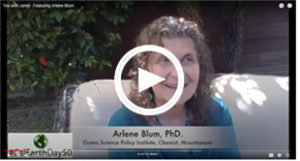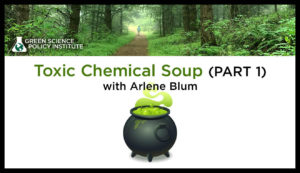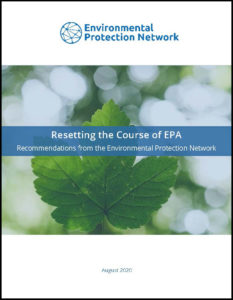August 2020 Newsletter – SO Great: A Wonderful Little Video
As this hot and challenging summer advances toward Labor Day, I hope you are finding time to enjoy the outdoors. So good to have a break from the many challenges we are facing: a fair election; how schools should best reopen; staying safe and healthy in mind and body. My vacations were close to home: walks at the Pt Reyes National Seashore and hikes in the Sierra foothills and the Desolation Wilderness.
At the Green Science Policy Institute, we feel so fortunate to be able to continue amidst many societal challenges to use good science to help government and business craft policies for healthier products and environment for all.
Our recent peer-reviewed paper presents a way to reduce chemical harm by managing the thousands of PFAS chemicals as one single class. The paper has already been viewed more than 18,000 times. We are delighted that the class concept is gaining traction with business and government. You can learn more about the paper and other happenings during the amazing day when it went online in the blurb below.
And you might enjoy some of my favorite videos on our YouTube channel. Also below, you can learn about safe and effective cleaning products to use instead of those containing harmful antimicrobials such as quaternary ammonium compounds (QACs or quats).
We have been working with our advisory board on a Scientists Letter on Reducing Chemical Harm for the federal government and realized that agency employees are most likely to know the details about what is needed in their agency. So we were delighted to learn that 500 past EPA employees have prepared a road map to guide that agency on priorities to carry out its mission more effectively as discussed below. If anyone knows of similar collaborations or documents to guide other agencies to get back on course, please do share with us.
I hope you will enjoy the news items below that our Institute’s team has written for you.
Arlene
P.S. Although November may seem far away, good to begin making your plan on where and how you will vote and encourage your friends and family to do the same. VoteAtHome.org is a great organization to support. Also, if you haven’t filled out your 2020 Census Form – please do it now! Your voice matters.
SO Great: A Wonderful Little Video!If you’re staying at home out of the heat, you might enjoy some recent videos on our Institute’s YouTube channel.
Day 1: Antimicrobials in the Time of Coronavirus
Please also check out my classic favorites:
|
A Road Map for Moving the EPA back to its MissionWe need a smart, dedicated and strong EPA to protect our climate, health, and environment. In spite of the hardworking and talented scientists and others at the EPA, the current leadership has stood in their way. Some very good news is that the Environmental Protection Network (EPN), an organization of more than 500 former career and appointed EPA employees, just released Resetting the Course of EPA. The report outlines specific and actionable steps that EPA leadership can take to reset the course of the agency to address the most significant threats to public health and our environment. Priorities include reducing chemical harm, combating climate change and reducing environmental risks and inequities. This high level report is accompanied by a letter of support signed by six former EPA administrators from both Republican and Democratic administrations and detailed papers that can be found at www.environmentalprotectionnetwork.org/reset. You can contact reset@environmentalprotectionnetwork.org to learn more or get involved. |
Scientists Say to Treat PFAS Chemicals as a ClassIn our peer-reviewed paper on treating PFAS chemicals as a class, 16 scientists–including four from our Institute–make the case that the extreme persistence and potential toxicity of PFAS render traditional one-at-a-time evaluation of chemicals inadequate and even dangerous. During our virtual press conference with Senator Blumenthal from Connecticut and Representative Kildee from Michigan, Linda Birnbaum, Detlef Knappe, Tom Bruton, and I spoke to 105 journalists and others about the class concept. Also see our July 15 Facebook Live conversation with Representative Madeleine Dean of Pennsylvania and Marta Venier which has remarkably already had 2.1 K views. On the same day our “PFAS as a class” paper was released, Senator Blumenthal and others introduced bipartisan bicameral legislation to reduce PFAS exposure among military families by stopping DOD purchasing of a range of products containing PFAS. Moving military purchasing away from PFAS will reduce the manufacture and global accumulation of these “forever chemicals.” Also on that day, my OpEd, “Will Congress finally address toxic forever chemicals?” was published in The Hill. I wrote it to bring more attention to the good work of EPA scientists as reported in Science, along with an excellent accompanying commentary. With brilliant scientific sleuthing, the researchers identified new PFAS pollution from a Solvay plant in New Jersey spreading across the Northeast. |
Avoiding both Harmful Antimicrobials and Covid-19By Anna Soehl Yet another worrisome impact of the coronavirus pandemic is the increased use of harmful or untested antimicrobial chemicals. For example, many popular cleaning products and disinfectants contain quaternary ammonium compounds (QACs or quats), which are associated with adverse health effects including asthma, allergen sensitivity, skin irritation, adverse respiratory, nervous system, immunological, reproductive and developmental effects. Quats have been recently added to the Biomonitoring California’s designated chemicals list. The use of such harmful chemicals is often unnecessary. More benign disinfectants include those based on alcohol, citric acid, lactic acid, or hydrogen peroxide. They are effective and EPA-approved for use against COVID-19 and other pathogens. Identifying safer and effective cleaning products and disinfectants can be daunting. Fortunately, the San Francisco Department of the Environment has a web tool on the SF Approved site that can help you buy the right products and use them correctly. Please share this link, especially with people who are in charge of cleaning and disinfecting. Also you might like to check out our Six Classes video on antimicrobials and a fun illustrated one minute video on the Florence Statement on the antimicrobials Triclosan and Triclocarban. |
Chemicals, Children, and CeliacBy Rebecca Fuoco Might your ability to eat pancakes be affected by the pan you use to make them? Celiac disease is a serious autoimmune disorder triggered by consuming a protein called gluten, which is found in wheat, barley, and rye. Common symptoms include diarrhea, bloating, gas, fatigue, and anemia. It can also lead to other health complications. The only treatment is a strict and lifelong adherence to a gluten-free diet, which can come with practical, social, and economic challenges. The researchers found that children and young adults with high blood levels of pesticides were twice as likely to be newly diagnosed with celiac disease. Girls with elevated levels of PFAS were five to nine times more likely to have the disease, and boys were twice as likely to be diagnosed if they had elevated blood levels of PBDEs. Celiac disease is known to be a genetic disorder, but less is known about environmental exposures that may affect its onset. The NYU study is the first to find a measurable link between diagnosis and chemical exposures. “These results also raise the question of whether there are potential links between these chemicals and other autoimmune bowel diseases, which all warrant close monitoring and further study,” said the study’s senior investigator and pediatric gastroenterologist Jeremiah Levine. You can read the full study in Environmental Research. |
CalendarOctober 15 & 16, 2020: Green Science Policy Workshop on Science & Policy of PFAS.
An interactive two-session virtual workshop, following the PFAS in Our World meeting
When: 1:00 PM – 3:30 PM Eastern Questions: Tom@GreenSciencePolicy.org
October 19-23, 2020: CWEA PFAS Summit
Arlene Blum will keynote the PFAS Summit at California Water Environment Association (CWEA) Annual Conference. Her talk is entitled: “PFAS: What It is, What It Comes From, Where It’s Found and Its Dangers”
November 30 & December 1: PFAS Conference in Berlin
Arlene Blum will be the keynote speaker for the PFAS conference, Dealing with Contaminants of Emerging Concern, sponsored by the German Environment Agency and the German Ministry for the Environment. Her presentation is entitled: “Reducing Harm from PFAS for a Healthier Environment”. Where: Berlin, Germany |






